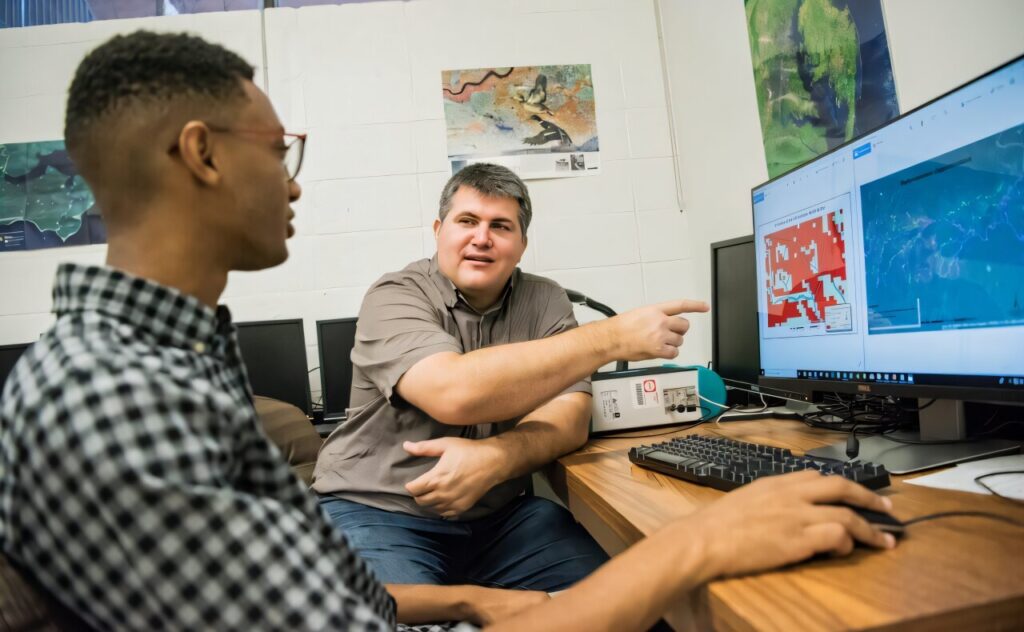

Joshua Slaughter (left) and Matthew Fagan discuss a map of forest areas in Costa Rica. A global map of potential natural reforestation areas developed in a Nature The study, led by Brooke Williams and Hawthorne Beyer and based on a global database of forest patches developed by Fagan, suggests that an area the size of Mexico in the tropics has the potential to regenerate and store 23.4 gigatons of carbon. Credit: Marlayna Demond/UMBC
or STUDY IN Nature reveals that up to 215 million hectares of land (an area larger than Mexico) in humid tropical regions worldwide has the potential to regenerate naturally.
That much forest can store 23.4 gigatonnes of carbon over 30 years and also have a significant impact on concerns such as biodiversity loss and water quality. The study showed that more than half of the area with strong potential for growth was in five countries: Brazil, Mexico, Indonesia, China and Colombia.
“Planting trees in degraded landscapes can be costly. By using natural regeneration techniques, nations can meet their restoration goals cost-effectively,” says study co-author Brooke Williams, a researcher at the University of Queensland Technology, Australia and Institute for Capacity Exchange in Environmental Decisions.
“Our model can guide where these savings can best be leveraged,” she says.
A culmination of decades of work
Matthew Fagan, associate professor of geography and environmental systems at the University of Maryland, Baltimore County (UMBC) and second author of the new study, developed a dataset that the authors relied on.
In that job“We used satellite images to identify millions of small areas where tree cover increased over time. We then excluded human-planted areas with machine learning, focusing on natural regeneration,” says Fagan.
The study tracked regeneration between 2000 and 2012 and then checked whether regeneration was sustained until 2015. “Those natural patches were the input for this new study,” he says, “the first to predict where regeneration will occur the future of forests, given a past regrowth.”
The study, co-led by Hawthorne Beyer, head of geospatial science at Mombak, a Brazilian startup that aims to generate high-quality carbon credits through Amazon reforestation, and director of science at the Institute for Capacity Exchange in Environmental Decisions, also drew on global datasets describing factors such as land quality, slope, road and population density, local wealth, distance from urban centers and healthy forests, and more.
“Any time you build one of these global studies, you’re standing on the backs of many other scientists,” Fagan says. “Each of these studies represents years of work.”
The study found that the factors most strongly associated with high regeneration potential were a patch’s proximity to existing forest, nearby forest density, and soil carbon content. These factors in particular “seem to do a really good job of explaining the patterns of resurgence that we see around the world,” Fagan says.
Being close to existing forest, for example, is key to supplying a variety of seeds to the area to support diverse regeneration, Fagan explains.
Keeping it local – providing a global map
The final product of the study is a digital map of the global tropics, where each pixel – representing 30 x 30 square meters of land – shows the estimated potential for regrowth. This map, made possible by a broad international collaboration of researchers, is a boon to environmentalists around the world who hope to advocate locally for their efforts.
“Our goal and our hope is that this will be used democratically by local people, organizations and localities from the county level to the national level to advocate for where restoration needs to happen,” Fagan says.
“The people who live there have to be responsible for what happens there – where and how to restore it really depends on local conditions.”
Fagan points out that some of the potential regeneration areas the study identified are unlikely to be restored for a variety of reasons, such as active use for livestock or crops or located on prime real estate near roads and urban centers.
However, a significant portion of the 215 million hectares is abandoned and degraded cattle pasture or previously logged forest, where encouraging natural regeneration would have minimal cost to local economies and a long list of benefits.
“If you restore it to the rainforest, the benefit to water quality, water security, local biodiversity and soil quality would be huge,” says Fagan.
“It would also be a tremendous benefit for getting carbon out of the atmosphere, so it’s really just a question of, ‘Where can we do this most efficiently?’ That’s what this paper is about.”
More information:
Brooke Williams, The Global Potential for Natural Regeneration in Tropical Deforested Regions, Nature (2024). DOI: 10.1038/s41586-024-08106-4. www.nature.com/articles/s41586-024-08106-4
Provided by
University of Maryland Baltimore County
citation: Natural regrowth of tropical forests has tremendous potential to address environmental concerns, study finds (2024, October 30) Retrieved on October 30, 2024 from https://phys.org/news/2024-10-natural-regrowth- tropical-forests-immense .html
This document is subject to copyright. Except for any fair agreement for study or private research purposes, no part may be reproduced without written permission. The content is provided for informational purposes only.